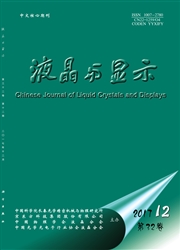

 中文摘要:
中文摘要:
将Alq作为覆盖层真空蒸镀到玻璃基板后制作底发射有机电致发光器件(OLED),所制备的器件结构为:Glass/Alq(xnm)/Al(15nm)/MoO3(30nm)/NPB(60nm)/Alq(65nm)/LiF(1nm)/Al(150nm)。通过研究器件光辐射特性曲线,可以看出覆盖层厚度的变化引起光的干涉效应的变化是导致电致发光变化的原因,广角干涉和多光束干涉之间的相互作用可以通过覆盖层的厚度来调节,并且半透明的Al膜做阳极,将覆盖层蒸镀到阳极之外玻璃基板上,半透明的铝膜和覆盖层与阴极组成微腔器件,通过改变覆盖层的厚度调节微腔的腔长,使OLED电致发光光谱的中心波长发生红移。
 英文摘要:
英文摘要:
A bottom emitting organic light-emitting devices was fabricated by depositing Alq as capping layer to the glass substrate. The device structure were Glass/Alq(x nm)/Al(15 nm)/MoO3(30 nm)/ NPB(60 nm)/Alq(65 nm)/LiF(1 nm)/Al(150 nm). By studying the radiation characteristics of the devices, it was found that the variation of the EI. emission due to the capping layer can be entirely accounted for a change in optical interference effects. The complex interplay between wide angle and multiple-beam interference can be controlled via the optical thickness of the dielectric capping layer on top of the cathode. Semitransparent Al film was anode. The capping layer deposited to the glass substrate formed microcavity devices with cathode. By changing the thickness of capping layer to adjust the microcavity length, the center wavelength El. spectra of OLED was red-shifted.
 同期刊论文项目
同期刊论文项目
 同项目期刊论文
同项目期刊论文
 Electroluminescence enhancement in blue phosphorescent organic light-emitting diodes based on differ
Electroluminescence enhancement in blue phosphorescent organic light-emitting diodes based on differ Aluminum/MoO3 anode thin films: An effective anode structure for high-performance flexible organic o
Aluminum/MoO3 anode thin films: An effective anode structure for high-performance flexible organic o Properties of Phosphorescent Organic Light-Emitting Diodes with Different Doping Order on Light Emit
Properties of Phosphorescent Organic Light-Emitting Diodes with Different Doping Order on Light Emit A New Non-Contact Method Based on Relative Spectral Intensity for Determining Junction Temperature o
A New Non-Contact Method Based on Relative Spectral Intensity for Determining Junction Temperature o Cathode Formed by Thermal Evaporation of Ba:Al Alloy and Estimations of Barrier Height in an Organic
Cathode Formed by Thermal Evaporation of Ba:Al Alloy and Estimations of Barrier Height in an Organic 期刊信息
期刊信息
